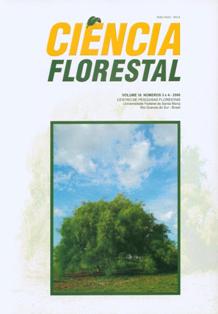STRUCTURAL DYNAMICS OF THE LAURACEAE COMMUNITY DURING 1995-2004 IN AN ARAUCARIA FOREST, SOUTHERN PARANÁ STATE, BRAZIL
DOI:
https://doi.org/10.5902/198050981917Keywords:
araucaria florest, phytosociology, forest dynamics, laurel trees.Abstract
Several species of Lauraceae family are among the most common ones in the Araucaria Forest. They have good silvicultural and economic potential, but unfortunately they are still very poorly studied. This paper analyzes the structural changes of eight species of Lauraceae family during 1995-2004 in a forest located in the center-south region of Parana State, Brazil. The species were investigated through structural and dynamic indicators: importance value (IVI), abundance, basal area, trunk volume, diameter distribution, spatial pattern, recruitment, mortality and increments. The results showed that the structural position of the Lauraceae family was kept almost unaltered in the community during the ten-year period. It was also noticed that the Lauraceae family is increasing in terms of abundance due to the fact that recruitment has been greater than mortality. However, growth rates have been very low, either in diameter and basal area/volume. Although most Lauraceae species show a slow dynamic behavior, some of them have experienced an intense chance process, such as Canela-amarela (Nectandra grandiflora Nees & Mart. ex Nees) which increased most of its structural and dynamic indicators, becoming the most remarkable species among all those studied. This species showed recruitment greater than mortality, a J-shaped diameter distribution and very wide spatial distribution. These elements have turned this species one of the three most important in the community together with Araucaria angustifolia (Bertol.) Kuntze and Ilex paraguariensis A.St.-Hil. It was concluded that, in ten years, it is already possible to distinguish important ecological processes that may be very useful in formulating Management Plans for similar Araucaria forests.Downloads
References
BARROS, P. L. C. Estudo fitossociológico de uma floresta tropical úmida no planalto de Curuá : uma Amazônia brasileira. 1986. 147f. Tese (Doutorado em Engenharia Florestal) – Universidade Federal do Paraná, Curitiba, 1986.
BITTENCOURT, S.; DALLA CORTE, A P.; SANQUETTA, C.R. Estrutura da comunidade de Pteridophyta em uma floresta ombrófila mista, sul do Paraná, Brasil. Silva Lusitana, v. 12, n. 2, p. 243-254, 2004.
INSTITUTO BRASILEIRO DE GEOGRAFIA E ESTATÍSTICA. Manual técnico da vegetação brasileira. Rio de Janeiro: IBGE, 1990.92p.
LONGHI, S. J. A estrutura de uma floresta natural de Araucaria angustifolia (Bertol.) Kuntze, no sul do Brasil. 1980. 198f. Dissertação (Mestrado em Engenharia Florestal) – Universidade Federal do Paraná, Curitiba, 1980.
PIZATTO, W. Avaliação biométrica da estrutura e da dinâmica de uma floresta ombrófila mista em São João do Triunfo–PR: 1995 a 1998. 1999. 172f. Dissertação (Mestrado em Engenharia Florestal) – Universidade Federal do Paraná, Curitiba, 1999.
SANQUETTA, C.R. Os números atuais da cobertura florestal do Paraná. 2004. 6p. Disponível em: Acesso em: 8 jan. 2004.
SANQUETTA, C.R.; MATTEI, E. Manejo racional da floresta de araucária. Revista Meio Ambiente de Santa Catarina, Florianópolis, v. 2, p. 58, 2002.
SANQUETTA, C. R. ; DALLA CORTE, A. P. ; EISFELD, R. L. Crescimento, mortalidade e recrutamento em duas florestas de araucária (Araucaria angustifolia (Bertol.) Kuntze) no Estado do Paraná, Brasil. Revista Ciências Exatas e Naturais, v. 5, n.1, p. 101-112, 2003.
SEELIGER, U; CORDAZZO, C.; BARBOSA, F. Os sites e o Programa Brasileiro de Pesquisas Ecológicas de Longa Duração. Belo Horizonte: FURGS/UFMG, 2002. 187p.
SCOLFORO, J. R. Manejo florestal. Lavras: UFLA/FAEPE, 1998. p. 225-229.







